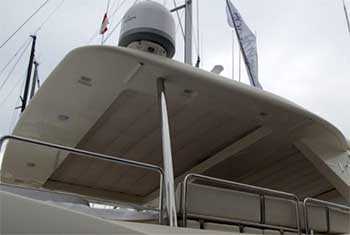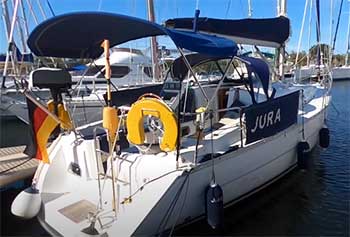Are you looking to get a new T-top canvas for your boat…probably from Stamoid or Weblon?
I mean, there is a massive difference in their durability factor. Even after seven years of use, you won’t have any issues with the Stamoid canvas material with proper care. But with Weblon will come across several issues within that period.
Now, this makes you wonder then what’s the difficulty in choosing between these two options. Well, just the durability may not cut out for some people.
That’s why diving deep into the comparison will give you a better picture of how the canvases differ. Then, based on the differences, you can find out which is best suited for your needs.
A Quick Comparison Of The Two T-Top Canvas Materials
| Specifications | Stamoid T-Top Canvas | Weblon T-Top Canvas |
| Material type | Woven polyester with multiple vinyl coatings | Traditional vinyl laminate |
| Handling | No trouble in handling | Tricky to handle |
| Maintenance | Easy clean with the lacquer coating | It can be a bit difficult to clean |
| Durability and strength | Very high in strength with excellent durability | Stiff and rough |
Key Differences Between Stamoid And Weblon T-Top Canvas
- Material Type

Let’s start with the materials you are dealing with here.
While both of them are vinyl, there is a difference in how they are made. This difference can have an impact on the buying decision for these materials.
Stamoid is mainly a type of woven polyester. So it’s not that authentic vinyl makes that you usually get to see in other canvas materials.
However, there is nothing to complain about the material. You still get the waterproofing that you desire from T-top canvas material.
And with the waterproofing, several other unique benefits make it a very appealing choice.
Weblon, on the other hand, is a natural vinyl-made fabric. It comes with a very traditional vinyl laminate on top. The laminate provides you with waterproofing for your T-top canvas.
It’s a pretty sturdy and stiff material so you can expect some form of durability. But it’s not the best, and I will discuss that later.
Overall, both the materials are pretty good. However, while Stamoid is a unique choice with its unique build, Weblon is a more traditional choice. So, if you want to take the modern route, go with Stamoid.
Otherwise, Weblon works out well.
- Handling
Now, the question here is, what does handling the materials mean?
Well, handling refers to how easy the material is to handle, especially for the installation. How easily you can shape or maneuver it can dictate your decision.
In terms of handling or maneuverability, I would lean towards Stamoid. The reason for that is its lighter weight.
Also, the material is a bit thin, which makes it easy to control and shape. You won’t struggle with the material too much when installing it on your T-top.
In contrast, Weblon is all about stiffness. It’s not as soft or as light as Stamoid. And that’s why it’s also a bit more challenging to handle—installing the material on your T-top as the canvas can be tricky when you do it all yourself.
So, considering the handling or installation factor, Stamoid is a better pick. You have an easier time with the material.
- Maintenance
A crucial thing about T-top canvases is the maintenance factor. You will want to keep it clean and tidy for the most part. So, an option that’s easier to clean and maintain will always be preferable.
Easy to maintain is one of the taglines that Stamoid use for their material. A lacquer coating on the top layer of the material makes it easy to clean. As a result, you don’t have to struggle or spend too much time cleaning the material.
Compared to that, cleaning the Weblon material is a bit tricky for sure. Because, unlike the Stamoid, Weblon is a laminate, so you must constantly think about delaminating the material.
Altogether, Stamoid is much easier to maintain without any worries at all. So, it’s undoubtedly a better choice than Weblon in that aspect.
- Durability And Strength

This factor is the one that should give you valuable information on which one to pick for your needs.
Because, trust me, you don’t want to replace your T-top canvas soon. It is essential to get the maximum durability and longevity out of them, if possible.
Stamoid does an excellent job of strength and eases keeping up with that factor.
The ease factor comes from the lightweight nature of the material.
But they somehow managed to keep the lighter while giving the high material strength. It’s not stiff, but it’s sturdy and withstands rough conditions.
The picture is quite the opposite when you get to the Weblon canvas material. First of all, they are very stiff and heavy in comparison.
But that’s not the biggest concern. The genuine concern is that you start facing issues like mildew stains and black spots. Another significant issue is that the material gets brittle after some years.
The clear winner here is Stamoid. It’s a more modern and revised material that provides effective results overall.
Also Read: 600 Or 1200 Denier Boat Cover?
Which T-Top Canvas Is A Better Pick For You?
In all honesty, I don’t think you can find anything to complain about Stamoid as a material. This factor alone tells you how good the material is for your T-top canvas.
Having said that, since it’s a bit lightweight, if you are from a very windy area, I would suggest getting Weblon over Stamoid.
Weblon is a lot stiffer and heavier. So, the advantage of Weblon is that they can withstand heavy gusts of wind better than Stamoid.
Conclusion
Summarizing the Stamoid vs. Weblon debate tells you that, Stamoid is a superior choice over the Weblon material. With the durability, weight, usability, installation, and maintenance in all aspects, Stamoid is a little bit ahead in the game.
Therefore, you will hardly find any complaints with the Stamoid material.
Does that mean Weblon is a bad material?
Well, no. But if you don’t want to deal with issues like mildew stains, black spots, or brittles in the material after some years, then avoid Weblon.

